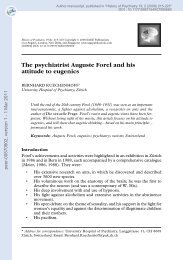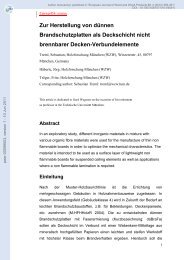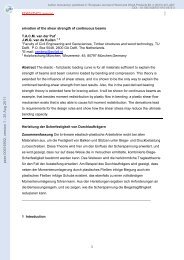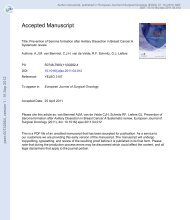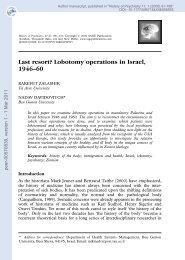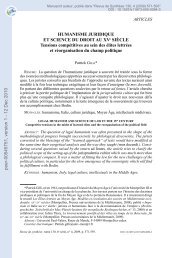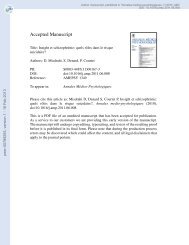Cosheaves and connectedness in formal topology
Cosheaves and connectedness in formal topology
Cosheaves and connectedness in formal topology
You also want an ePaper? Increase the reach of your titles
YUMPU automatically turns print PDFs into web optimized ePapers that Google loves.
peer-00821313, version 1 - 9 May 2013<br />
(3) Let B i ⊆ (≤ γ A) (i ∈ I) be a family of pairwise disjo<strong>in</strong>t opens cover<strong>in</strong>g<br />
≤ γ A. We must show (≤ γ A) ⊳ B i0 for some (unique) i 0 .<br />
S<strong>in</strong>ce γ ∈ π 0 (A), we can f<strong>in</strong>d a ∈ ↓ A <strong>and</strong> δ ∈ π 0 (a) such that γ = <strong>in</strong> a (δ),<br />
<strong>and</strong> then (by Lemma 17) some (a ′ , δ ′ ) ≤ (a, δ) with a ′ ≤ δ a. Now a ′ ∈ (≤ γ A),<br />
so a ′ ⊳ a ′ ↓ ⋃ i∈I B i. Hence for some i 0 ∈ I there is some b ∈ a ′ ↓ B i0 <strong>and</strong><br />
ε ∈ π 0 (b) with (b, ε) ≤ (a ′ , δ ′ ). We shall show that i 0 is unique once γ is given,<br />
<strong>and</strong> it will follow that (≤ γ A) ⊳ B i0 .<br />
First, suppose a, δ, a ′ <strong>and</strong> δ ′ are given but we have (b λ , ε λ ) ≤ (a ′ , δ ′ ) (λ =<br />
1, 2) with b λ ∈ a ′ ↓ B iλ . Then there is a connection from (b 1 , ε 1 ) to (b 2 , ε 2 )<br />
<strong>in</strong> a ′ ↓ ⋃ i∈I B i. Therefore, to show i 1 = i 2 , we can assume without loss of<br />
generality that (b 1 , ε 1 ) ≤ (b 2 , ε 2 ). Then b 1 ∈ B i1 ↓ B i2 ⊳ {c ∈ P | i 1 = i 2 } <strong>and</strong><br />
from positivity of b 1 (as witnessed by ε 1 ) we deduce i 1 = i 2 .<br />
Now suppose a <strong>and</strong> δ are given, but we have a ′ λ , δ′ λ , b λ, ε λ <strong>and</strong> i λ (λ = 1, 2).<br />
There is a connection from (a ′ 1, δ 1) ′ to (a ′ 2, δ 2) ′ <strong>in</strong> ⋃ {≤ α a | α ∈ π 0 (a)}, but<br />
clearly this must be <strong>in</strong> ≤ δ a. Hence to show i 1 = i 2 we can assume without<br />
loss of generality that (a ′ 1, δ 1) ′ ≤ (a ′ 2, δ 2). ′ Then b 1 ∈ a ′ 2 ↓ B i1 <strong>and</strong> ε 1 ∈ π 0 (b 1 )<br />
with (b 1 , ε 1 ) ≤ (a ′ 2, δ 2) ′ <strong>and</strong> it follows by uniqueness with respect to (a ′ 2, δ 2) ′ that<br />
i 1 = i 2 .<br />
F<strong>in</strong>ally, suppose just γ is given, <strong>and</strong> we have a λ , δ λ , a ′ λ , δ′ λ , b λ, ε λ <strong>and</strong> i λ<br />
(λ = 1, 2). There is a connection from (a 1 , δ 1 ) to (a 2 , δ 2 ) <strong>in</strong> ↓ A <strong>and</strong> so to show<br />
i 1 = i 2 we can assume without loss of generality that (a 1 , δ 1 ) ≤ (a 2 , δ 2 ). But<br />
then a ′ 1 ≤ δ2 a <strong>and</strong> (a ′ 1, δ 1) ′ ≤ (a 2 , δ 2 ) <strong>and</strong> it follows from uniqueness with respect<br />
to (a 2 , δ 2 ) that i 1 = i 2 .<br />
From the Proposition we see that (i) the opens ≤ γ A are the connected<br />
components of A, <strong>and</strong> (ii) the connected components of the open A are <strong>in</strong><br />
bijection with the elements of π 0 (A), so π 0 is <strong>in</strong>deed the connected components<br />
cosheaf.<br />
6. Complete spreads<br />
In [2, Section 2.4] a key use of a cosheaf F over X is to def<strong>in</strong>e a locale over X,<br />
by “amalgamation”. The locale maps obta<strong>in</strong>ed <strong>in</strong> this way are called complete<br />
spreads. The doma<strong>in</strong> is always locally connected, with F (U) isomorphic to the<br />
set of connected components of the <strong>in</strong>verse image of U. (When X is itself locally<br />
connected, the connected components cosheaf π 0 gives as complete spread the<br />
identity map on X.) This is analogous to the way ([3], [21]; see also [4]) a<br />
sup-preserv<strong>in</strong>g function F : ΩX → Ω gives rise to a sublocale of X.<br />
This Section is restricted to the <strong>in</strong>ductively generated case. In the follow<strong>in</strong>g<br />
Def<strong>in</strong>ition, I do not know how to describe the full cover relation for the complete<br />
spread (except <strong>in</strong> the particular case where F is a connected components cosheaf<br />
π 0 – see Proposition 31).<br />
In [2], the Def<strong>in</strong>ition here is best compared with their Proposition 2.4.1.<br />
They have a site (C, J) <strong>in</strong> which C is a category correspond<strong>in</strong>g to the poset P<br />
here. (Their sites are for toposes, i.e. generalized spaces.) The J-sieves then<br />
correspond to the basic covers a ⊳ 0 U. (Or, rather, to a ⊳ a ↓ U. This is<br />
19



